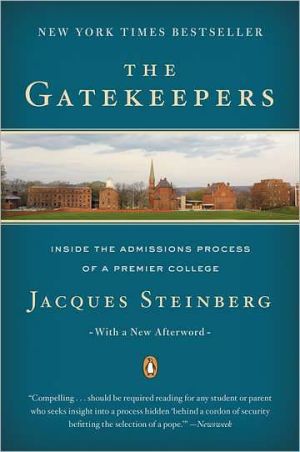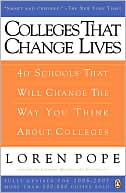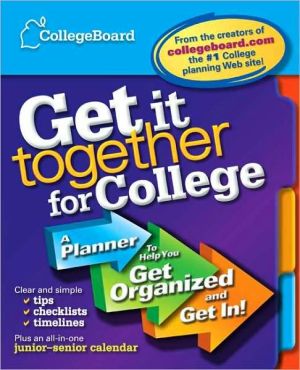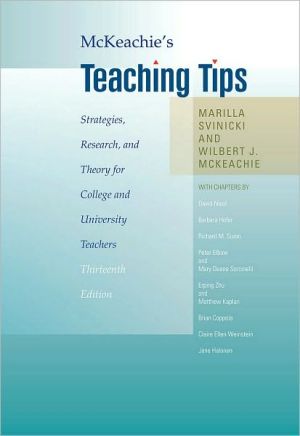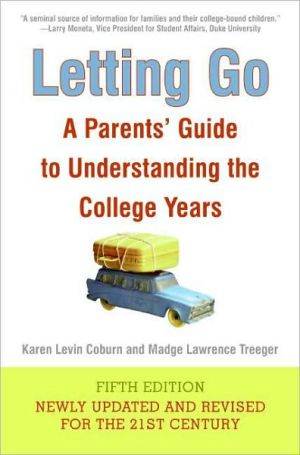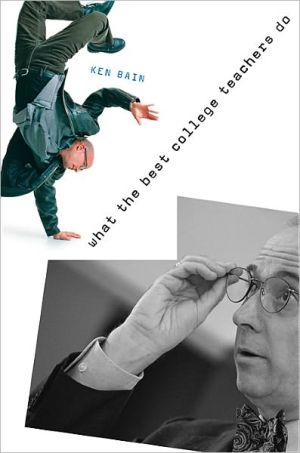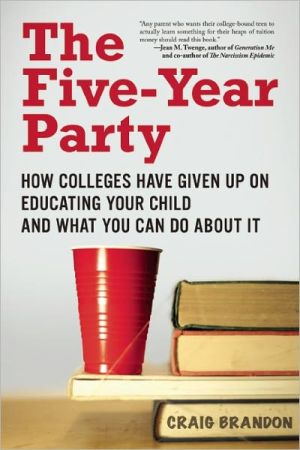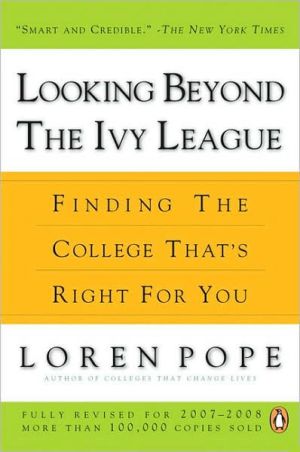The Gatekeepers: Inside the Admissions Process of a Premier College
In the fall of 1999, New York Times education reporter Jacques Steinberg was given an unprecedented opportunity to observe the admissions process at prestigious Wesleyan University. Over the course of nearly a year, Steinberg accompanied admissions officer Ralph Figueroa on a tour to assess and recruit the most promising students in the country. The Gatekeepers follows a diverse group of prospective students as they compete for places in the nation's most elite colleges. The first book to...
Search in google:
In the fall of 1999, New York Times education reporter Jacques Steinberg was given an unprecedented opportunity to observe the admissions process at prestigious Wesleyan University. Over the course of nearly a year, Steinberg accompanied admissions officer Ralph Figueroa on a tour to assess and recruit the most promising students in the country. The Gatekeepers follows a diverse group of prospective students as they compete for places in the nation's most elite colleges. The first book to reveal the college admission process in such behind-the-scenes detail, The Gatekeepers will be required reading for every parent of a high school-age child and for every student facing the arduous and anxious task of applying to college. Publishers Weekly Education reporter Steinberg presents a compelling tale in this account, told from the perspective of Ralph Figueroa, an admissions officer at Wesleyan University. Expanding on a series of articles in the New York Times, Steinberg provides an insider's look at how Figueroa and the school's admissions committee factored grades, test scores, essays, extracurricular activities and race into account as they winnowed 700 students for the class of 2004 from nearly 7,000 applicants. Using real names, applications and interviews, Steinberg follows six applicants of varying backgrounds from their first encounter with Figueroa to their final acceptance or rejection. Although not a how-to book per se, Steinberg's work does include helpful advice, such as "there's no way to outthink this process" and "if you've got something you want to write, then write it the way you want." Steinberg portrays Figueroa and the other admissions officers as doing the best they can to give each applicant a fair assessment, despite their responsibility for 1,500 of them. Among the book's surprises are that supplementary material, no matter how impressive, carries no weight in deciding who gets in, while honesty about a mistake in one case, an incident involving a pot brownie can influence an admissions officer to admit. Wesleyan's high standards e.g., a 1350 combined score on the SAT may put some readers off, but the process that Steinberg describes is similar at most private colleges and universities. Copyright 2002 Cahners Business Information.
One\ The Tortilla Test\ The lime-green Saturn raced along the winding roads of northern New Jersey, past trees strung with leaves that glowed tangerine, gold and maroon. But the driver was too preoccupied to notice the glorious foliage, his eyes continually darting to the passenger seat. There he had laid out travel directions printed from the Internet, along with a well-worn road atlas pocked with green asterisks spread across a half dozen states. Each designated a community that he had visited previously.\ On that bracing morning in early November of 1999, Ralph Figueroa was beginning his fifth year as an admissions officer at Wesleyan University, in Middletown, Connecticut, one of the nation's premier liberal arts colleges. But from the vantage point of a passing driver, Ralph was just another motorist wearing a gray wool suit, white starched shirt and deep red tie. He sat hunched over the wheel of a rental car that was too small to contain his body, which unfolded to more than six feet and weighed well over two hundred pounds. With his thick, blown-back black hair, which he had neatly arranged at a Courtyard by Marriott just after daybreak, Ralph looked like someone on his way to sell a $350 vacuum cleaner, rather than the product of a $35,000-a-year education that came with the unwritten guarantee of a happy and meaningful life.\ At ten-thirty, a few minutes early as usual, Ralph pulled up in front of Northern Valley Regional High School in Demarest, a boxy, tan-brick public school that looked nothing like the private Tudor-style academy that he had left a half hour before. This was his second sales call of the day, and one of four visits that he had scheduled within a fifty-mile radius. He had allotted just six hours for the day's work, so he would have to speak quickly. As he moved purposefully past green-tiled walls and gray lockers on the way to the guidance office, he fumbled to pin on a plastic badge embossed with his name and that of Wesleyan in big letters.\ The popular image of university admissions officers is not unlike that of Hollywood studio executives. Both are assumed to spend most days sitting imperiously behind desks well out of reach of the general public, from which they deign to approve only a fraction of the endless series of pitches that are presented to them in rapid-fire succession. But to the handful of seniors and juniors who sat around a conference table that autumn morning listening to this smiling emissary on leave from his ivory tower, the message was unmistakable: Wesleyan Wants You! The university's gates, it seemed, had been flung wide open. And here, before their very eyes, was one of the gatekeepers who could escort them in.\ From his seat beneath a giant map of the United States that a guidance counselor had labeled "College Acceptances"-so far, it had only one pin pushed into it, in the vicinity of Wilkes University in the Pocono Mountains-Ralph belied the familiar notion of admissions officer as intimidator. His voice was as soothing as a pediatrician's. He urged them to call him Ralph, not Rafael, his given name, and certainly not Mr. Figueroa.\ The pitch Ralph delivered to his small audience seemed to promise that Wesleyan could fulfill virtually anyone's fantasy of higher education, if only the students would give the university the chance. And just to make sure that the students kept a vivid snapshot of the Connecticut campus projected on the screens in their minds, the university had sent along piles of posters of a Wesleyan landmark, Foss Hill, photographed on a fall day as beautiful as this one.\ Even a devoted alumnus might not have noticed that the creaky football bleachers had been digitally removed, as had the many patches of brown dead turf. Instead, the late-fall grounds had the freshly tended appearance of the infield at Fenway Park. While the poster made a good first impression, some applicants would be disappointed when they saw the real thing. The curriculum, as described by Ralph, sometimes received a similar gloss.\ "One of the first things to remember about the university is that there are no requirements," Ralph told the assembled group, tantalizing them with the prospect of never again having to take a dreaded subject like math or chemistry. "Wesleyan stresses a real-world approach."\ Moreover, Ralph explained, while other institutions had begun only recently to appreciate and celebrate the differences among students, "We started our focus on diversity in 1965."\ "That's the year I was born," he said, before adding that thirty-four years was indeed "a long time ago."\ Almost immediately, the students' hands shot up. Would there be opportunities at Wesleyan to perform in a musical? one girl asked.\ "Wesleyan does a lot of theater," Ralph responded. He mentioned that a first-string quarterback had played the lead in a recent production of Sweeney Todd, and that Wesleyan had a disproportionate share of alumni working in Hollywood. They included the writer of Batman Forever, the director of American Pie and the actor William Christopher, who, Ralph assured his listeners, would be well known to their parents as Father Mulcahy on M*A*S*H.\ Just then a girl interrupted: Was the biology department any good?\ "The physical sciences faculty does more research than just about any other liberal arts college," Ralph said. "Haverford beat us," he added. "But don't tell anyone."\ Was there enough time for students at Wesleyan to study and to play sports?\ "We want students to be scholar-athletes," Ralph said. Nearly two-thirds of Wesleyan undergraduates played an intramural or team sport. "The only thing that students do more of than sports at Wesleyan is community service."\ How's the food?\ One of the high school seniors, who had already visited a friend on the Wesleyan campus, answered before Ralph could. "There's always free frozen yogurt in the cafeteria," she said, describing the unique donation of a wealthy alumnus with a sweet tooth.\ "Ice cream, too," Ralph added, sounding like Willie Wonka beckoning kids to the chocolate factory.\ How fast are the Internet connections?\ "Very fast," Ralph said.\ Were there cable television jacks in the dorm rooms?\ Ralph smiled. "There actually are," he said.\ Only two questions drew answers that dimmed the Technicolor portrait that Ralph was painting that morning. But, then, an admissions officer from almost any other college would have had to give the same responses, if he or she was being honest.\ One was posed by a serious-looking boy, who inquired: "Do you have any Nobel Prize winners on the faculty?"\ "We don't have any Nobels," Ralph admitted, momentarily taken aback. "But we do have professors who have won Guggenheim and MacArthur and other grants."\ The boy had been advised by his father, a Yale-educated ophthalmologist, to ask Ralph this question, and was obviously unimpressed.\ The other tough question was a follow-up to Ralph's earlier point about diversity.\ "Do the races mix?" he was asked.\ "Yes and no," Ralph answered. Wesleyan had acquired nicknames like "PCU" and\ "Diversity U" by attracting and admitting more black and Hispanic students than nearly any other top school, Ralph told his audience. "People think it's a place where students are holding hands and singing 'Kumbaya.' "\ But, he had to acknowledge, "There is a tension. It's a process to address these issues and forge a community. Students will mix together one moment, only to segregate afterward."\ And then, nearly an hour after his sales call had begun, it was over.\ After making a note to contact the campus rabbi on behalf of one student, and passing out business cards with his e-mail address to several others, Ralph was back in his rental car and on his way to the next group of potential customers: a high school in the neighboring community of Ridgewood. He had spoken too long, and as he turned right onto Oradell Avenue, he was going to have to rush to make it on time.\ But in all the talking he had done at Northern Valley Regional High, Ralph had neglected to mention a fact that the students surely would have found relevant: Wesleyan had just come off a year in which it had attracted a record number of applicants. Nearly 7000 students had sought the 715 spots available in the freshman class-almost 10 applicants for each seat. Though the university had offered admission to more than 715, because some of those accepted would invariably choose to go elsewhere, Wesleyan had still rejected 7 of every 10 who applied. The median SAT score of those admitted-a combined 1370 on a scale of 1600-was not only the highest in Wesleyan's history, but also higher than that of all but a handful of other colleges.\ And as Ralph spoke, two months before all applications were due, there were already indications that this year would be even more competitive, with thousands more students projected to graduate from American high schools than in the previous school year. Rather than spend six weeks of the fall on the road courting applicants, as Ralph and his eight other colleagues from the admissions office were doing, they could easily have stayed home and still assembled a stellar class-several classes, in fact, given the pool of highly qualified applicants. But like a politician wading into a room full of strangers, Ralph and his colleagues were not going to rest until they had given every last college applicant a reason to cast a vote for Wesleyan.\ Ralph had a particular voter in mind. He was hoping to seize the imagination of that elusive senior who hadn't given Wesleyan much thought, if he or she had given it any thought at all, but who appeared to have credentials so impeccable as to fairly sail through the admissions process. Ralph knew, though, that in his quest to find such a prize he was inviting most of his listeners to submit a fifty-five-dollar application fee sheerly for the privilege of being rejected.\ "You realize that, further down the line, a lot of these kids will end up applying and being denied," Ralph said later. "But you can't really think about that at this stage. This stage is about figuring out which students should be considering Wesleyan, which students really need to have us on their radar screens. At this stage, I want everyone who could possibly benefit from Wesleyan to have that chance. They'll never get in if they don't try."\ That may seem like a cute way to do business, but at the very moment that Ralph and his colleagues were fanning across the country and around the world, admissions officers from four dozen other highly selective colleges-including Harvard and Haverford, Swarthmore and Stanford, Princeton and Pomona-were spending tens of thousands of dollars, and hundreds of hours, on similar expeditions. Like Wesleyan, each had received a record or near-record number of applicants the previous winter. Nonetheless, each was intent on assembling a class that was a little bit better than last year's-and, if possible, a little bit better than almost every other institution's. As Ralph and his colleagues saw it, so worthy was the goal of putting together such a community that it justified the difficult and sometimes cruel practicalities that were required to make it happen.\ In recent years, the elite colleges had become something like combatants in a global arms race, a contest in which strength would be measured by stockpiles of candidates arranged by test scores, grade point averages, outside interests and skin color. None of the institutions was willing to be the first to stand down and pronounce itself content with its lot.\ "No one is staying static," said Barbara-Jan Wilson, who had left the deanship of the Wesleyan admissions office over the previous summer to become the university's vice president for university relations, which meant she had gone from sweet-talking applicants to sweet-talking donors.\ "Schools under us are trying to pick off the kids in our applicant pool," she explained, ticking off college names like Trinity, Bates, Muhlenberg and Connecticut. "Meanwhile, we're trying to pick off Brown's kids and Yale's kids."\ "Maybe we're just keeping up with the Joneses," she added. "But it's bigger than that."\ In truth, Wesleyan was part of a distinct minority within the academy that fall: one of only about fifty American colleges that reject more students than they accept. The lion's share of the nation's two thousand four-year colleges take almost anyone who applies. Yet each year, an increasing number of American teenagers flood those brand-name institutions with a disproportionate number of applications. One explanation for this, apart from the larger student population, surely lies with their parents, who were impressing ever more strongly on their offspring that a blue-chip education is the key to a successful life. First- and second-generation Americans, whose own parents had been content to see them graduate from any college, were now advising their own children and grandchildren that only a marquee name would be acceptable. In addition, elaborate online tours were now making it possible for students and parents from as far away as Wyoming and New Mexico to roam the academic epicenter of the northeast without ever leaving home.\ A university is only as good as its students, so why shouldn't Ralph seek to lure the best that were out there? Those turned back from the Wesleyan gate would surely find a place elsewhere, a fact in which Ralph took great comfort. More important, since Harvard and Yale and Brown were rejecting more applicants than ever, Wesleyan had a real shot at getting some students whom it might have lost to the Ivies a decade ago-if only enough of them knew Wesleyan's name and philosophy, and could be persuaded to choose Wesleyan over its more immediate competitors, including Williams and Amherst.\ Other than those fortunate enough to be accepted, the most immediate beneficiaries of all this wooing would be Wesleyan's professors. Like gardeners, the university's faculty members needed fertile minds in which to plant the seeds of knowledge, and when they weren't satisfied with the quality in a given year-if there were too few Russian majors or not enough budding microbiologists, for example-the professors were never shy about telling the administration. Also paying close attention to Ralph's efforts were the university's alumni, who were particularly gratified when Wesleyan snared a hot prospect-academic, as well as athletic-from a competitor. That swelling pride was often all it took to nudge a willing alumnus to contribute upward of a million dollars to his alma mater, which in turn made it possible for the institution to seek to attract even better applicants.\ But in building its arsenal of top students-with "top" variously defined as those who checked "valedictorian" on their applications; those with decent test scores who identified themselves as black or Hispanic; or those who played the bassoon-Wesleyan was also seeking to impress demanding audiences far from its Connecticut campus.\ For the last two decades, much of the pressure on admissions officers like Ralph had been applied by a group of observers who had assigned themselves the task of rating universities as if they were sports teams or stocks. Chief among the unofficial evaluators was U.S. News & World Report. In 1985 the magazine, long obscured by the more widely read Time and Newsweek, stumbled upon a niche by developing its own formula to handicap the top educational institutions in America. One crucial component in the magazine's assessment was the percentage of applicants that an institution accepted-the lower the better, as the editors believed. U.S. News also tabulated the percentage of accepted students who chose to matriculate at that institution, a number it wanted to be as high as possible.\ At once responding to and stoking Americans' obsession with elite colleges, U.S. News's annual education issue had become essential reading for teenagers, joined on their bookshelves by similar book-length guides published by such disparate companies as The Yale Daily News, Barron's, Peterson's and the test-prep upstart Princeton Review. All compiled admissions statistics liked those that filled U.S. News. Edward B. Fiske, a one-time education editor of The New York Times (and a 1959 Wesleyan graduate), had, with his annual Fiske Guide to Colleges, assumed the mythic status of a Broadway theater reviewer, his recommendations so influential that they could determine how tens of thousands of students might perceive a college for an entire year and beyond.\ If Ralph had stayed home that fall, and Wesleyan's numbers fell, its rankings in these publications could plummet. And as a study coauthored by a Cornell professor in 2000 suggested, after an institution's standing in U.S. News fell, so, at times, did the number and quality of its applicants.\ "I am an agent of the institution," Ralph said in an interview that fall. "And as an agent of the institution, I am trying to get as many students to apply to the institution as I can. Yet I like to focus on the more human perspective: there are going to be students who discover Wesleyan who wouldn't have otherwise."\ Whatever was motivating Ralph, his journey remained forever uphill, the summit always seeming to move higher. That was evident as he wearily took stock at the end of that day he spent in northern New Jersey. At the first three high schools he had visited, each of which was considered among the better-performing in the state, fewer than ten students had turned out to see him. And while nineteen juniors and seniors filled a conference room at his final stop, a relatively new public school called the Bergen Academies, the students had been required to attend by their guidance counselor.\ Asked later by another visitor if Ralph's talk had swayed them in any way, most of those he met that day listed first choices that were not Wesleyan. One boy with a high SAT score at Dwight-Englewood School, a respected prep school, said he was seeking early admission to Connecticut College because he "had a feeling" about the place. Another girl said she'd consider Wesleyan "if I don't get into Hopkins." Students at Bergen Academies ranked Princeton and Brown, as well as Vassar and Rutgers, ahead of Wesleyan.\ Almost all of the students, though, promised Ralph that they would apply to Wesleyan, and experience had taught him that such students usually did. Wesleyan's numbers might well be up this year, and that would mean he was doing a critical part of his job well.\ Still, the more successful he was in the fall, the more applications he would have to read in the winter. And that would only make it harder to make his final selections in the spring.
Introductionvii1The Tortilla Test12Don't Send Me Poems273Istanbul (Not Constantinople)554Considered Without Prejudice895Read Faster, Say No1196Thundercats and X-Men1497Nothing to Do with the Dope1738Things Seem to Have Gone Well1999420-ed21910Unnamed Gorgeous Small Liberal Arts School235Epilogue263Acknowledgments287Selected Bibliography291
\ From Barnes & NobleBased on a much discussed New York Times front-page series, The Gatekeepers takes you inside the admissions department of a top American college to reveal every step of the decision-making process. Granted unfettered access to the admissions offices at Connecticut's prestigious Wesleyan University, Steinberg follows several high school seniors as they vie for entry into college. He takes you through every phase of the selections; from reading applicants' essays to evaluating interviewees to comparing test scores. While examining factors such as high school grades, SAT scores, and extracurricular activities, he discusses hot educational topics such as affirmative action, standardized testing, test preparation courses, and the real value of "name-brand" colleges. Fascinating; intense; required reading for parents.\ \ \ \ \ Publishers WeeklyEducation reporter Steinberg presents a compelling tale in this account, told from the perspective of Ralph Figueroa, an admissions officer at Wesleyan University. Expanding on a series of articles in the New York Times, Steinberg provides an insider's look at how Figueroa and the school's admissions committee factored grades, test scores, essays, extracurricular activities and race into account as they winnowed 700 students for the class of 2004 from nearly 7,000 applicants. Using real names, applications and interviews, Steinberg follows six applicants of varying backgrounds from their first encounter with Figueroa to their final acceptance or rejection. Although not a how-to book per se, Steinberg's work does include helpful advice, such as "there's no way to outthink this process" and "if you've got something you want to write, then write it the way you want." Steinberg portrays Figueroa and the other admissions officers as doing the best they can to give each applicant a fair assessment, despite their responsibility for 1,500 of them. Among the book's surprises are that supplementary material, no matter how impressive, carries no weight in deciding who gets in, while honesty about a mistake in one case, an incident involving a pot brownie can influence an admissions officer to admit. Wesleyan's high standards e.g., a 1350 combined score on the SAT may put some readers off, but the process that Steinberg describes is similar at most private colleges and universities. Copyright 2002 Cahners Business Information.\ \ \ Library JournalNew York Times education reporter Steinberg takes us behind the scenes to experience the arduous and even grisly process of admissions at a major New England college. From fall 1999 to spring 2000, Steinberg shadowed Wesleyan University admissions officer Ralph Figueroa as he traversed the country recruiting students. The author had the unprecedented opportunity to attend admissions meetings with Figueroa and his colleagues in which the applicant pool of 7000 was reduced to 700 openings. Steinberg also followed six students through the admissions process and carefully documented their personal experiences, backgrounds, and interactions with the admissions officers to discover why some students stand out in the officers' memories and actually become bargaining chips in meetings with their colleagues. Although the author explicitly states that this is not another "how-to" manual for gaining admission to college, it nonetheless reveals that there are no set formulas and that the decision rests on factors that may not be wholly within the control of the applicant. This insightful and readable book should be purchased by all academic and large public libraries. [Previewed in Prepub Alert, LJ 5/15/02.]-Mark Alan Williams, Web Lib. & Document Storage Svcs., Hines VA Hosp., Chicago\ \ \ \ \ School Library JournalAdult/High School-Steinberg had unparalleled access to the admissions process for the class of 2004 at Wesleyan, an elite liberal arts college in Connecticut. Originally presented as a series of articles in the New York Times, the stories were so compelling and the subject matter so topical, that he was convinced to expand them to book length. He followed Ralph Figueroa, a veteran admissions officer, for eight months, encompassing initial "marketing" trips, contacts with high school guidance counselors, the early-decision process, reading thousands of applications for final admissions, wooing reluctant candidates, and fighting for specific marginal cases. Evident throughout is the truth of Figueroa's assertion that there is no way to guarantee admission or any one thing that will make a certain candidate successful. Several high school seniors allowed the author to record their thoughts and concerns as he simultaneously followed the progress of their applications. While the close examination emphasizes the seeming inconsistency of the process, the resulting epiphanies and changes in perspective of the individuals followed in the year's march to college allow readers to see that a big name is not necessarily everything and that some students are much happier in a different atmosphere. The stories are so well written that teens will find this title a pleasurable read in the midst of much practical advice.-Susan H. Woodcock, Fairfax County Public Library, Chantilly, VA Copyright 2003 Reed Business Information.\ \
